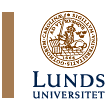

|
Panel No. 26Panel Title: Globalization, technological advances and minority languages in South AsiaConvenor: Anju Saxena, Department of Linguistics, Uppsala University Friday 9 July, 8–12 & 13–18 Panel Abstract: The old quip attributed to Uriel Weinreich, that a language is a dialect with an army and a navy, is being replaced in these progressive days: a language is a dialect with a dictionary, grammar, parser and a multi-million word corpus of texts – and they’d better all be computer tractable. When you’ve got all of those, get yourself a speech database, and your language will be poised to compete on terms of equality in the new Information Society. (Ostler 1998) The increasing internationalism in the twentieth
century with a small group of nations dominating the scene, has
had an adverse effect on the maintenance of social and cultural
traditions of many communities. According to Krauss (1996), 3000
of today’s 6000 languages will disappear in this century,
if no extra measures are taken. Issues relating to language death,
endangernment and threat to linguistic diversity have dominated
the scene (Krauss (1996), Hale (1992)) and efforts to revitalize
endangered languages and to regress the phenomenon of language death
have been the themes of several conferences (including UN conference).
Papers accepted for presentation in the panel:Paper Giver 1: Jens Allwood, Department of Linguistics, Göteborg University, Sweden Paper 1 Title: Language survival kits Paper Abstract: to be delivered Paper Giver 2: Lars Borin, Department of Swedish, Gothenburg University, Sweden Paper 2 Title: Resuing NLP resources in documenting minority languages Paper Abstract: It could be argued that language technology has been shaped by the typological and other traits of the most explored language, namely English. However, English is in some respects an atypical language, and it would consequently be a mistake to believe that traits such as the ones listed and others will be characteristic of all or a large number of languages. I hasten to add that these traits are found in other languages, too, and not only in those genetically or geographically close to English. My point – which I am not the first to have made – is simply that there is an abundance of languages which work differently from English, and the question then rightly raises itself, whether the same language technology methods which have worked so well for English will work equally well for languages drastically different from English in these and other respects. In this presentation I will raise some questions concerning the state of Language Technology today and some possible ways of applying this technology to lesser-known languages. Paper Giver 3: Eva A. Csato, Department of Linguistics and Philology, Uppsala University, Sweden Paper 3 Title: The role of multimedia publications in the maintenance of endangered languages Paper Abstract: The talk will describe
a multimedia, community-based approach to the documentation of the
highly endangered Karaim language in Lithuania and experiences gained
through applying multimedia products in the revitalisation of this
language. Karaim is a Kipchak Turkic language spoken today
of about forty speakers in Lithuania. The language has retained
some archaic features, and has partly undergone a typological metamorphosis
due to changes induced by intensive contact with Slavic and Baltic
languages. Paper Giver 4: Martin Gaenszle, Heidelberg and Leipzig, Germany Paper Title: Digitizing endangered speech traditions in east Nepal: The Chintang / Puma Documentation Project (DOBES) Paper Abstract: Chintang and Puma are two little known Kiranti languages which are highly endangered. Chintang is spoken mainly in one Village Development Committee, and nowhere else, while Puma, though being a bit more widespread, is increasingly replaced by Bantawa, a local lingua franca. Both languages are affected by the dominance of Nepali, the national language. The Chintang / Puma Documentation Project, undertaken under the DOBES Programme (financed by the Volkswagen Foundation), aims at a comprehensive linguistic documentation of the present speech practices: it also comprises the study of child language acquisition (in the case of Chintang) and the documentation of ethnographic conditions, including the oral and ritual tradition. Recordings are done mainly with digital video equipment, and the resulting data will be eventually stored and made accessable (within limits) in a digital archive at the Max Planck Institute at Nijmegen. The paper will give an overview of the project, including a demonstration of the resulting format. Paper Giver 5: Colette
Grinevald, Université Lyon 2 and CNRS, France Paper Abstract: To be delivered Paper Giver 6: Arthur Holmer & Jan-Olof Svantesson, Department of Linguistics & Phonetics, Lund University, Sweden Paper 6 Title: The changing language situation of the Kammu Paper Abstract: Kammu is spoken by approximately 500.000 people in northern Laos. Due to social factors (in particular as a consequence of the Vietnam war) most Kammu villages were abandoned and today, people of Kammu ethnicity live in mixed communities together with speakers of Lao Lum (Lao), Lao Sung (Hmong-Mien). As a result of assimilation, there are hardly any monolingual Kammu speakers left. This has also had an effect on the language itself: in this presentation, it will be shown how not only the Kammu lexicon, but also the grammar of the language, is changing, adopting features which are clearly Lao in origin. This process, which was evident already before traditional Kammu society started to disintegrate, is accelerating, and in this respect, while Kammu is not an endangered language numerically speaking, it might be argued that Kammu in its non-assimilated form is not only severely endangered, but in fact almost extinct. Paper Giver 7: Abdulaziz Y. Lodhi, Uppsala University, Sweden Paper 7 Title: Sidhi, the East African community in Gujarat: Globalization in earlier days and their situation today Paper Abstract: In the face of globalization
which seems to make the world become more inter-connected, and individual
countries more intra-connected, ethnicity is increasingly emphasised
in many parts of the world where claims to specific local identities
and renewed or (re)constructed authenticity are more loudly presented. Paper Giver 8: Michael Noonan, University of Wisconsin-Milwaukee, USA Paper 8 Title: Ethnic Consciousness and the Politicization of Language in West-Central Nepal Paper Abstract: The aim of this
paper is to describe the state of play between the rise of ethnic
consciousness and attitudes toward language of some Tibeto-Burman
speaking peoples of west-central Nepal. The main points to
be discussed are 1) that language issues have not yet been pushed
to the forefront of the political agenda, and 2) that ethnic organizations
are still at the beginning stages of dealing with matters of documentation,
standardization, and orthography of their ancestral languages. Paper Giver 9: Anju
Saxena, Uppsala University, Sweden & Udaya
Narayana Singh, CIIL, India Paper Abstract: Our aim here to present the research project Digital documentation of Indian minority languages of which Anju Saxena is the Principal Investigator and Udaya Narayana Singh is the Principal Collaborator . The aim of this project is to collect, organize and disseminate information on some lesser-known Indian languages, many of which are threatened with extinction. The project will include linguistic documentation (i.e. texts and speech files) as well as documentation anchoring this linguistic material to social and cultural aspects of these communities. The results of this project will directly as well as indirectly combat the phenomenon of language death by both spreading awareness about these lesser-known languages and by documenting them. To that extent, this project will also be a contribution to work on language endangerment. Paper Giver 10: Udaya Narayana Singh, Central Institute of Indian Languages, Mysore, India Paper 10 Title: Status of smaller languages of India and language technology Paper Abstract: The paper is clearly
divided into two parts – one dealing with issues of theoretical
importance that focus on development of smaller languages in a diverse
space, and the other presenting a profile of such smaller and lesser-known
(and often, least cared for) languages of South Asia. Paper Giver 11: Karina Vamling, School of International Migration and Ethnic Relations, Malmoe University, Sweden Paper 11 Title: Caucasian database: demonstration Paper Abstract: The aim of the database is to
make available on the internet fully glossed examples in several
Caucasian languages, showing a number of different grammatical constructions
such as morphological causatives, ergative clauses, inversive constructions,
evidentials, complex cross-reference marking. The database includes
over 600 sentences in Old and Modern Georgian, as well as the lesser-known
languages Megrelian (South Caucasian/Kartvelian), Kabardian and
Adyghe (West Caucasian). The examples are accessible by search for
(1) grammatical categories, (2) prefixes and suffixes, (3) roots
of the original language, (4) stems of the language of translation
(English). Paper Giver 12: Dr. Karl-Heinz Grüssner, Universitätsbibliothek Tübingen, Germany Paper 12 Title: Khasi: a minority language of North–East India. From an unwritten to a written language Paper Abstract: The University Library of Tuebingen belongs to a group of German libraries which were selected by the Deutsche Forschungsgemeinschaft (German Research Foundation) for its programme of the so-called Sondersammelgebiete (Special Collection Fields). Tuebingen is responsible for collecting materials on South Asia. Among these a minor section, the collection of Khasi books, has been chosen to represent a small language of the Indian North East and its development from an unwritten language to a written literary language and to point out how this language is used nowadays in private and public affairs, which efforts are made to preserve and to promote the language and which goals have yet to be achieved. Full paper to be downloaded (as a pdf-file) List of participants:Anju Saxena, Associate Professor, Department of Linguistics, Uppsala University, Sweden Jens Allwood, Professor, Department of Linguistics, Gothenburg University, Sweden Lars Borin, Professor, Natural Language Processing, Deparment of Swedish, Göteborg Univeristy, Sweden Colette Grinevald, Professor, Université Lyon 2 and CNRS, France Éva Csató Johanson, Associate Professor, Department of Asian and African Languages, Uppsala University, Sweden Östen Dahl, Professor, Department of Linguistics, Stockholm University, Sweden Arthur Holmer, Associate Professor, Department of Linguistics, Lund University, Sweden Gunilla Gren-Eklund, Professor em, Department of Asian and African Languages, Uppsala University, Sweden Abdulaziz Y. Lodhi, Associate Professor, Department of Asian and African Languages, Uppsala University, Sweden Michael Noonan, Professor of Linguistics, Department of English, University of Wisconsin, Milwaukee, USA Udaya Narayana Singh, Professor and Director, Central Institute of Indian Languages, Manasagangotri, Mysore, India Jan-Olof Svantesson, Professor, Department of Linguistics, Lund University, Sweden Karina Vamling, IMER, Malmö University College, Sweden
SASNET - Swedish South Asian Studies Network/Lund
University
|

